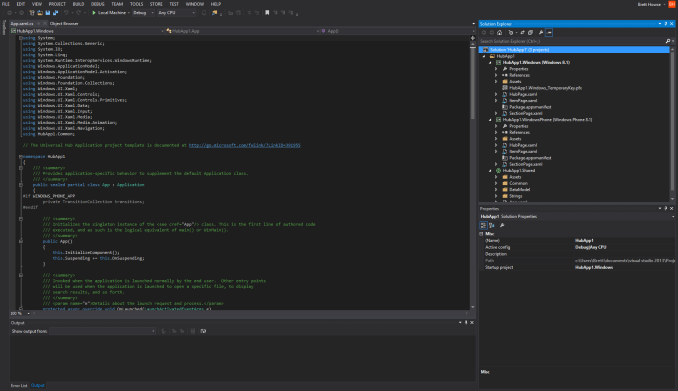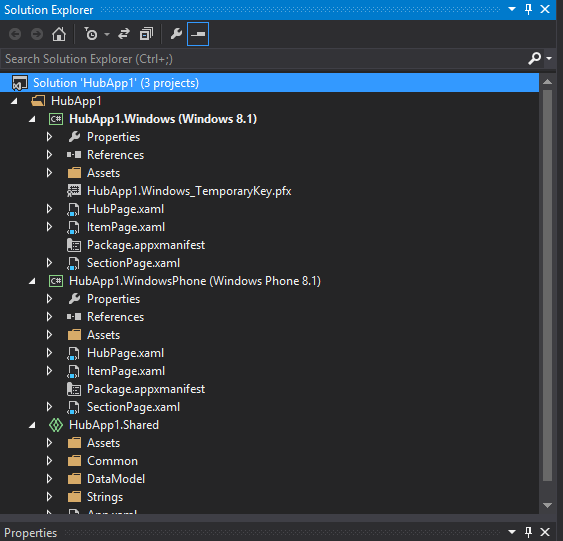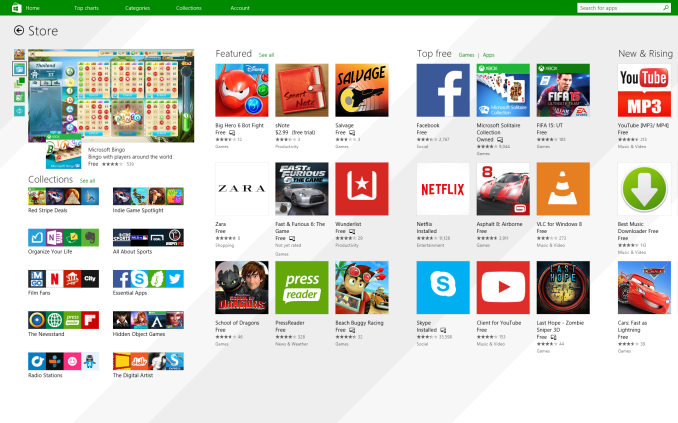Windows 10 Technical Preview First Impressions: The Return Of The Desktop
by Brett Howse on November 13, 2014 8:00 AM EST- Posted in
- Software
- Microsoft
- Windows 10
Universal Apps and the Windows Store
We just got done discussing why a single user interface for the OS across multiple devices is not always the ideal solution, so of course the obvious question with Universal Apps is why would you want it with the app model instead? Thankfully this is not the case although the term Universal App might lead people to believe they are attempting to have a single app target all of their platforms. The truth of the matter is that Universal Apps are Universal in the sense that they share a common app store.
If Microsoft is going to have Windows 10 succeed on desktops, laptops, tablets, phones, and even Xbox One, they need developer buy-in. A platform without apps is not much use to anyone. With the Universal App, they can bridge all of their platforms with a single App in the store. Under the hood, each app is created with a common framework of code, as well as multiple user interfaces in order to tailor the experience to the correct device type. Below is a screenshot of Visual Studio – Microsoft’s developer tools – with a new Universal App about to be created.
 Visual Studio Showing a Universal App Project
Visual Studio Showing a Universal App Project
As you can see, there is a shared portion of code, and then a project for the UI for Windows 8.1, and Windows Phone 8.1. Xbox One is not available yet, but should be added in a future release of Visual Studio.
A close up of the projects
But you may be wondering why any of this is necessary. Windows has the largest selection of applications of any system ever. That is of course true, and the Win32 framework has served both Windows and its users well over the years. But with the new WinRT framework there are some big advantages. First, it can be written to in multiple languages including HTML. WinRT supports C++/CX, C#, VB.NET, and HTML scripting with JavaScript and TypeScript. The security model for WinRT apps is a lot different than Win32, with all WinRT apps running in a sandbox mode for higher security. Unlike apps written in .NET, WinRT is native code, which should result in better performance. Contracts and Extensions are also new to WinRT, and allow apps to share data while still being in a sandbox. One of the biggest advantages of WinRT is that it is DPI aware, and can automatically scale apps appropriately based on screen size and screen resolution. Here, as we know, Win32 apps can struggle even though there are solutions in place.
Adobe Touch WinRT (left) vs Adobe Reader Win32 (right) on HiDPI display
One of the biggest disadvantages of WinRT is that it is only available on Windows 8 and newer devices. With Windows 8 struggling in the market as compared to Windows 7, the user reach of a developer targeting WinRT apps in the Windows Store would be for a subset of the total user base. With Windows 7 having over 50% of the desktop OS market share to itself, this is going to be an issue.
With Windows 10, Microsoft is certainly targeting Windows 7 users. If they can convince them to upgrade to the latest version of the operating system, then the new environment will have a much larger target base and will hopefully encourage developers to target the Windows Store. We have not heard of any upgrade promotions or pricing yet, but this is one of the biggest advantages Apple has had over the years. Their user base generally upgrades the OS at a much faster uptake than Windows. This allows developers to utilize newer APIs in the latest versions of their operating systems and keep the platform progressing. Microsoft has already had to deal with people being stuck on Windows XP, and they must be wanting to avoid that with Windows 7.
Since we are discussing Universal Apps and their advantages, one of the biggest advantages is the Windows Store. With Microsoft hosting the entire download and purchase of all WinRT apps, having user settings and apps sync from one device to another is much easier. One of the greatest experiences with Windows 8.1 is signing into a new PC for the first time. When you log in with your Microsoft Account, the system asks you if you would like to copy the devices and apps from one of your other devices, or if you want to start with a clean machine. If you choose a previous machine, all of the settings, wallpaper, Start Screen layout, and Windows Store apps are synced to the new device. In the case of Windows Store apps, the app itself is listed on your Start Screen, but it is not downloaded until the first time you select it. This avoids a situation where you will significantly delay the initial login time with a massive download, as well as avoid filling the available storage with apps you may not need on that particular device.
Also, like modern tablet and smartphone OSes, WinRT apps from the store are automatically kept up to date by the store. This avoids a lot of the issues with viruses and malware attacking an older version of a product since in theory it will not be around any longer.
The one thing missing from this are the older Win32 apps on the desktop, because they are not available in the Windows Store. Prior to Windows 10, desktop apps could be listed in the store, but the store would then link to the developer’s website to allow you to purchase and install the app. With Windows 10, rumors are that desktop apps will also be available and managed through the Windows Store. Assuming this does happen, then this will be a major boon to users. Desktop apps should in theory also be able to be kept up to date using the Windows Store which should cut back on the number of outdated pieces of software targeted by malware.
The Windows Store is a key piece of Windows 10. Universal Apps can be made available for multiple platforms through the store, and, if the rumors are true, even desktop apps will be available through the store. This should make the Out Of Box Experience (OOBE) very good for users with a Microsoft Account. The WinRT framework has not yet had the killer app written for it, so hopefully with Windows 10 the framework will be expanded to allow for more powerful apps to be created.













198 Comments
View All Comments
inighthawki - Friday, November 14, 2014 - link
The two are very orthogonal. If you think more monitors replaces virtual desktops, then you clearly don't understand the purpose for virtual desktops at all.Multiple monitors are about multitasking in a single scenario. e.g. I can have visual studio open on one monitor while a web browser shows documentation for the API I'm using on another, Virtual desktops is about separation of unrelated scenarios. One virtual desktop may have work related tasks and programs open (e.g. outlook, word, visual studio), while another virtual desktop has personal stuff (e.g. web browsing, netflix).
I also work in a programming environment where I work on enlistments of projects simultaneously (i.e. different views of the same source repository). Being able to have one enlistment per desktop is an excellent separation of data that I'm greatly looking forward two while using my multi-monitor setup at work.
Donkey2008 - Wednesday, November 19, 2014 - link
"One virtual desktop may have work related tasks and programs open (e.g. outlook, word, visual studio), while another virtual desktop has personal stuff (e.g. web browsing, netflix)"That's the best explanation of v-desktops I have heard so far. Common users will understand that without confusing tech mumbo jumbo talk.
TEAMSWITCHER - Saturday, November 15, 2014 - link
So what you're saying is that Microsoft has trouble implementing even 1990's era technology? I see your point.name99 - Saturday, November 15, 2014 - link
"now a days we have dual / tri/ quad monitor setup. works much much better."Nowadays? I used a setup of three 19" (CRT) monitors when I worked at Apple, starting from about 1992...
Two primary use case for virtual desktops, at least in the case of OSX are:
- laptops
- HTPCs (where virtual desktops are perhaps not essential, but they come along for the ride when you full screen an app, and many people use multiple video viewing apps)
In both these cases the whole POINT is that multiple hardware screens are not really a sensible option.
Gigaplex - Friday, November 14, 2014 - link
"Windows 10's implementation as it exists today has jarring transitions with no ability to move windows between desktops or change the rearrange the desktops."It is hidden, but you can move windows between desktops.
inighthawki - Friday, November 14, 2014 - link
I think it's also safe to say that this is a tech preview (i.e. a beta) so there's probably more left to do.milkod2001 - Thursday, November 13, 2014 - link
First slide on top has text: One product family, One platform and One Store with MS w10 logo(some MS exec has probably spent 5 min. designing that using Word and thought it' cool :)Will any x86 desktop app work on windows smartphone or tablet as slide indicates? Or at least all new apps from MS store will work 100% across all platforms?
Overall Windows 10 looks very promising.I have to give MS team credit for bringing start button back(it only took them 2 years), beautiful tiles are still there with quick access to all trends, FB, Twitter is there as well, some nice pictures and lets not forget MS Store if you want to buy some fantastic App...
Gigaplex - Friday, November 14, 2014 - link
Desktop apps will not work on phones. Only WinRT ("Metro") apps work on all platforms.name99 - Saturday, November 15, 2014 - link
" One product family, One platform and One Store"Microsoft's attitude to this is beyond retarded. On even numbered days they trump this "one, one, one" to the skies; on odd numbered days they assure us loudly that that is past, that now they care about the best UI and best code for every distinct platform.
The way they are treating this bears all the marks of a company that doesn't have a clue what it's strategy REALLY is. Satya either can't make up his mind on this, or he HAS made up his mind, but he can't get half the company to go along with what he has said...
Xajel - Thursday, November 13, 2014 - link
The thing I'm missing is the way a Microsoft account works, It will use the email, password, the full name registered in the account... and I can't change these without affecting my MS account... I hate that and I like to use my nickname rather than my full name, and a different password than my MS account password.. not to mention I don't like to see the name/email in the c:\users\NAME